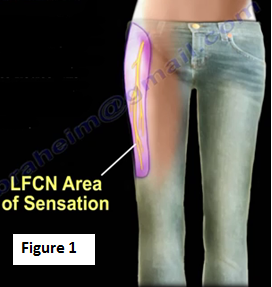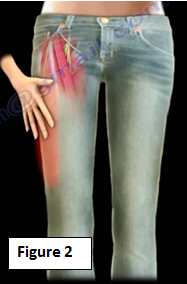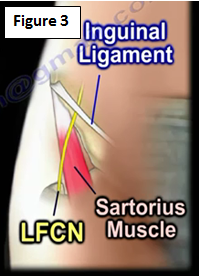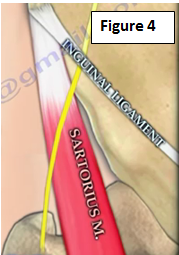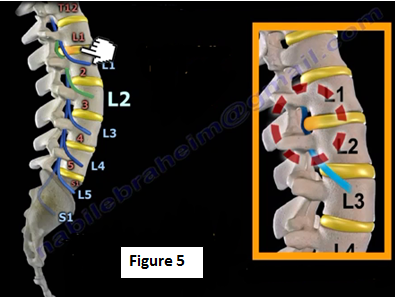Meralgia paresthetica is a pain or burning sensation felt over the anterolateral aspect of the thigh usually caused by compression, of the lateral femoral cutaneous nerve (LFCN) (Figure 1).
Wearing super tight jeans may cause this compression of the LFCN. Usually the patient complains of tingling, numbness and pain as well as sensitivity to touch in the area of the skin (Figure 2) innervated by the nerve (the outer part of the thigh).
There will be hypersensitivity over the anterolateral aspect of the thigh and the patient will sometimes notice this sensitivity while placing their hand or car keys inside the pocket.
Causes:
There are multiple factors that can cause meralgia paresthetica. These include tight pants, belts, corset braces, obesity/weight gain, pregnancy, local trauma and diabetes. Injury is usually caused by compression as the nerve passes under the inguinal ligament (Figure 3).
Anatomy of the LFCN:
The LFCN usually passes under the inguinal ligaments approximately 2 cm medial to the ASIS. Once outside the pelvic, the nerve splits and pierces the fascia, running over the lateral aspect of the thigh in the subcutaneous region and lies superficial to the sartorius muscle (Figure 4).
Disc herniation that affects the L2 and L3 nerve roots can also cause symptoms that are similar to meralgia paresthetica. A herniated disc at L1-L2 bulge will affect the L2 nerve root (Figure 5). When there is a disc herniation located at L2-L3 bulge, the L3 nerve root will be affected. Consider spine pathology when dealing with meralgia paresthetica.
Signs:
Signs to look for when questioning the presence of meralgia parethetica are a burning/tingling sensation and hypersensitivity to heat (warm water will feel like it is burning the skin). The condition is usually diagnosed by the patient describing the symptoms on the area of the thigh. Some people say it is an elusive or obscure diagnosis for many physicians and can be missed or overlooked. It can lead to a significant disability if missed. The condition could be mistaken for other disorders. Physicians may think it is a hip, groin, abdominal or iliotibial band problem. This can cause misdiagnosis and may lead to other unnecessary treatment given to the patient.
Treatment:
Many of the treatment options for meralgia parethetica are conservative. This treatment will include physical therapy, anti-inflammatory medications, weight loss, strengthening of the abdominal muscles, and to avoid wearing tight clothing and tight bands around the pelvis. Steroid injection can also be utilized. An ultrasound guided injection is probably better than a blind injection. The injection can be diagnostic and therapeutic, aiding in the diagnosis. Surgery can be done, but only in severe cases. Surgery is the last resort in order to decompress the nerve.
For more videos, check out my YouTube channel:
https://www.youtube.com/user/nabilebraheim/videos
